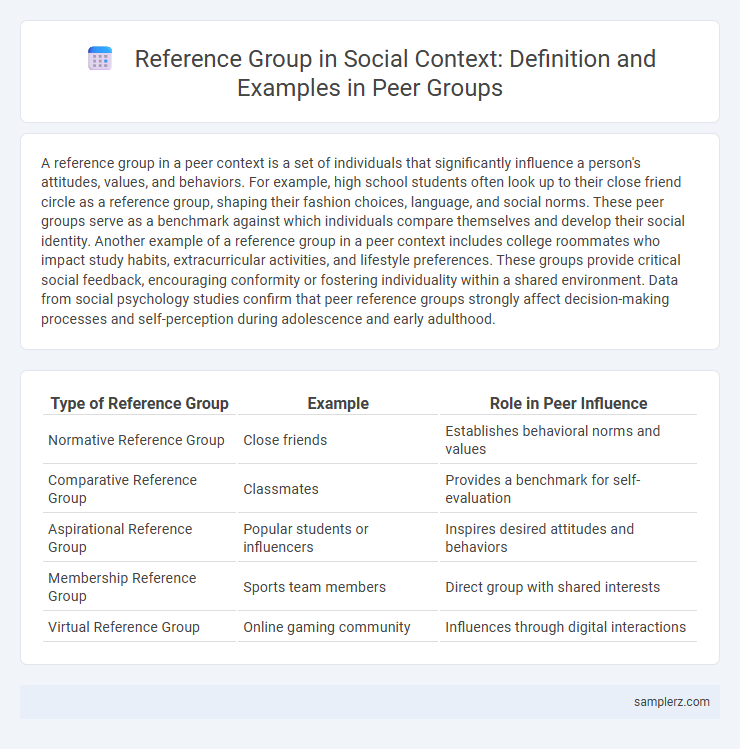A reference group in a peer context is a set of individuals that significantly influence a person's attitudes, values, and behaviors. For example, high school students often look up to their close friend circle as a reference group, shaping their fashion choices, language, and social norms. These peer groups serve as a benchmark against which individuals compare themselves and develop their social identity. Another example of a reference group in a peer context includes college roommates who impact study habits, extracurricular activities, and lifestyle preferences. These groups provide critical social feedback, encouraging conformity or fostering individuality within a shared environment. Data from social psychology studies confirm that peer reference groups strongly affect decision-making processes and self-perception during adolescence and early adulthood.
Table of Comparison
| Type of Reference Group | Example | Role in Peer Influence |
|---|---|---|
| Normative Reference Group | Close friends | Establishes behavioral norms and values |
| Comparative Reference Group | Classmates | Provides a benchmark for self-evaluation |
| Aspirational Reference Group | Popular students or influencers | Inspires desired attitudes and behaviors |
| Membership Reference Group | Sports team members | Direct group with shared interests |
| Virtual Reference Group | Online gaming community | Influences through digital interactions |
Understanding Peer Reference Groups in Social Settings
Peer reference groups, such as close friends or classmates, significantly influence individual attitudes, behaviors, and social norms in various contexts. These groups serve as benchmarks for self-evaluation and guide decision-making processes, especially during adolescence when identity formation is critical. Understanding the dynamics within peer reference groups helps reveal how social conformity and group cohesion impact personal development and social interactions.
Key Characteristics of Peer Reference Groups
Peer reference groups consist of individuals of similar age, interests, and social status who significantly influence attitudes, behaviors, and social norms. Key characteristics include shared values, consistent interaction, and mutual identification, which foster strong peer pressure and social conformity. These groups act as a benchmark for self-evaluation and guide decision-making in social and consumer contexts.
Influence of Peer Groups on Individual Behavior
Peer groups, such as close friends and classmates, exert significant influence on individual behavior by shaping attitudes, values, and social norms. These groups often serve as primary reference points for decision-making, impacting choices related to fashion, language, and risk-taking activities. The social pressure within peer groups can lead individuals to conform in order to gain acceptance and reinforce group identity.
Types of Peer Reference Groups in Society
Reference groups in peer settings include normative groups that influence individuals' values and behaviors, such as close friends or family circles. Comparative groups provide benchmarks for self-evaluation, like school classmates or colleagues. Aspirational groups consist of individuals one admires and aims to emulate, for example, celebrities or professional athletes.
Real-Life Examples of Peer Group References
Teenagers often look up to their close friends when choosing fashion styles, music preferences, and social behaviors, reflecting the impact of peer reference groups. In sports teams, athletes emulate their teammates' training habits and strategies to improve performance, showcasing peer group influence on skill development. College students frequently adopt study techniques and academic goals observed in their peer circles, demonstrating how peer reference groups shape educational choices.
Peer Group Dynamics and Social Identity
Peer groups influence individual behavior and self-concept through shared norms, values, and social interactions, shaping social identity formation. Reference groups within peer dynamics provide standards for comparison, fostering a sense of belonging and guiding attitudes and behaviors. Understanding these dynamics reveals how group membership impacts identity development and social cohesion among adolescents and young adults.
Positive Impacts of Peer Reference Groups
Peer reference groups, such as close friends or classmates, significantly shape individual behavior by reinforcing positive social norms and promoting healthy habits. These groups provide emotional support and motivation, enhancing self-esteem and encouraging academic or professional achievement. Membership in a constructive peer reference group fosters a sense of belonging and accountability, leading to improved decision-making and personal growth.
Peer Pressure: A Double-Edged Sword
Peer pressure exemplifies a reference group's influence, where adolescents often conform to friends' behaviors, attitudes, and values to gain acceptance. This social influence can encourage positive actions like academic achievement or discourage harmful behaviors such as substance abuse. Understanding peer pressure as a double-edged sword highlights the critical role reference groups play in shaping individual decision-making and social identity.
Reference Groups and Adolescent Development
Reference groups such as close friends and school peers significantly influence adolescent identity formation and social behavior by providing norms, values, and role models. These groups impact decision-making processes and self-esteem during critical developmental stages. Interaction within peer reference groups guides adolescents in establishing their social roles and personal beliefs.
Strategies to Navigate Peer Reference Group Influence
Peer reference groups such as close friends, classmates, or social media communities significantly influence individual behavior and decision-making. Effective strategies to navigate this influence include developing strong self-awareness, setting personal boundaries, and critically evaluating group norms before adopting them. Emphasizing authentic values and seeking diverse perspectives help maintain independence while engaging positively within peer groups.

example of reference group in peer Infographic
 samplerz.com
samplerz.com